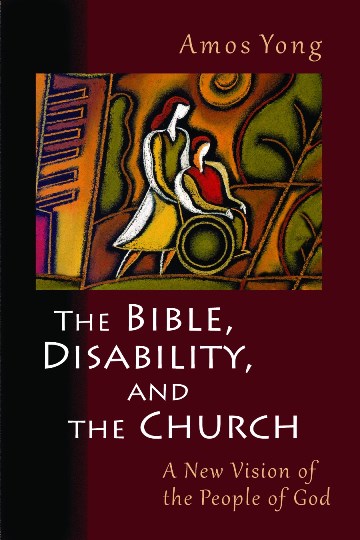Amos Yong: The Bible, Disability, and the Church
 Amos Yong, The Bible, Disability, and the Church: A New Vision of the People of God (Grand Rapids: Eerdmans, 2011), viii+ 161 pages.
Amos Yong, The Bible, Disability, and the Church: A New Vision of the People of God (Grand Rapids: Eerdmans, 2011), viii+ 161 pages.
Amos Yong is professor of theology and mission and director of the Center for Missiological Research at Fuller Theological Seminary, Pasadena, California. His other books include The Spirit Poured Out on All Flesh (2005), Theology and Down Syndrome (2007), and Hospitality and the Other (2015). One might ask what qualifications – if any – an able-bodied man has to write about disability. Yong answers this concern by noting his own experience being a brother of a man who suffers from trisomy-21, otherwise known as Down syndrome. As such, he has manifold practical experience in working with those who are disabled. As a man who is himself intellectually disabled, although I function at a relatively high level (I suffered a traumatic brain injury in 1995), I welcome Yong’s re-visioning and re-interpretation of the relevant biblical texts that concern the topic of disability, even though that term is anachronistically applied to the bible itself.
This is Yong’s first venture into a full-fledged book about biblical theology. The present title could be aptly seen as a biblically oriented complement to his more theologically minded title from 2005, Theology and Down Syndrome. This title is about disability, from beginning to end. However, it is also about the church. More than that, it is about what it means to “be” and “do” the church in light of the experience of disability. Building on the primal work in Theology and Down Syndrome in which Yong approached the intersection of theology and disability from an explicit theological perspective as a systematic theologian, addressing questions that spanned the theological loci of the doctrine of creation, providence, the person of Christ, and theological anthropology, this present book furthers his insights into how we as the corporate people of God might revise negative theological understandings of disability with the goal of creating a more hospitable and inclusive world for those who are afflicted with disablement. The present book differs in a number of manners, however. For example, whereas Theology and Down Syndrome was intended for theologically minded audiences, the present book is aimed at a more popular audience, with Yong foreseeing this text being the topic of group bible studies and religious education, to name just a couple of uses. Additionally, whereas Theology and Down Syndrome deployed theological modes of argumentation, the present book is primarily concerned with biblical interpretation. Third, the present book explicitly discusses the “so then” aspect of application, whereas Theology and Down Syndrome was largely theoretical. If Theology and Down Syndrome could be seen as being designed to change the way we think about disability, one might say that this present text is designed to transform the way we live with disability both practically and – especially – ecclesially.
Yong makes several affirmations that are important and relevant to readers of Pneuma Review. For example, he asserts that people with disabilities are created in the image of God, which is measured by the personhood of Christ, and not our understandings of normalcy. Additionally, he avers that people with disabilities are people first, meaning that they are not to be defined by their disability. Third, he contends that disabilities are not necessarily evil or blemishes to be avoided and eliminated, but that instead people with disabilities (I resonate with this assertion) are constituted by their disabilities, and thus to remove them from their disablement would be to remove an intrinsic part of their identity.
In sum, Yong proposes a new “portrait” for what it means to be the whole people of God that both values and is inclusive of those who are marked by disablement. He suggests a “charismatic fellowship” of the Spirit that both blesses and is blessed by people with disabilities. Pointedly, he addresses what it means to be the church if we are to go beyond the damning dichotomy that renders so many of us disabled individuals on the periphery of society. Yong views the bible as a source of redemption for the experience of disability.
Reviewed by Bradford McCall
Publisher’s page: http://www.eerdmans.com/Products/6608/the-bible-disability-and-the-church.aspx
Category: Ministry, Winter 2017


